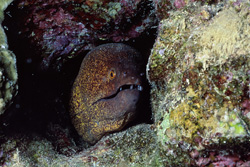Explore the Fascinating World of Giant Moray Eels (Gymnothorax javanicus), Impressive Marine Creatures with Unique Features and Behaviors in Tropical Waters.
The Giant Moray Eels (Gymnothorax javanicus) belong to the family of moray eels and are native to the warm, tropical waters of the Indo-Pacific region. Growing up to 3 meters in length, they are among the largest species within the moray family. These marine serpents are characterized by their elongated bodies, powerful jaws, and sharp teeth, making them effective hunters in their habitat. Giant morays prefer rocky reefs and coral reefs, where they hide in tight crevices and caves to protect themselves from predators and to ambush their prey. Their diet primarily consists of fish, crustaceans, and other small marine animals, which they skillfully surprise and overpower. Reproduction occurs through external fertilization, with females releasing several thousand eggs per spawning event. The young eels leave the nest after hatching and go through various developmental stages before reaching their full size. Giant moray eels are also known for their striking patterns and vibrant colors, making them a popular observation target for divers. Their presence plays a significant role in the ecosystem by helping to control the populations of other marine species. Although generally harmless to humans, interactions with giant morays should be handled with care and respect to avoid danger to both the animals and people. Overall, giant moray eels are fascinating representatives of marine fauna, whose understanding and protection are essential for maintaining biodiversity in the oceans. Marine biology, ecology, and the conservation of aquatic habitats are crucial to preserving balance in tropical ecosystems. Additionally, giant morays provide valuable insights into the adaptability of marine animals to various environmental conditions and play a role in research on biodiversity and sustainable ocean management.

